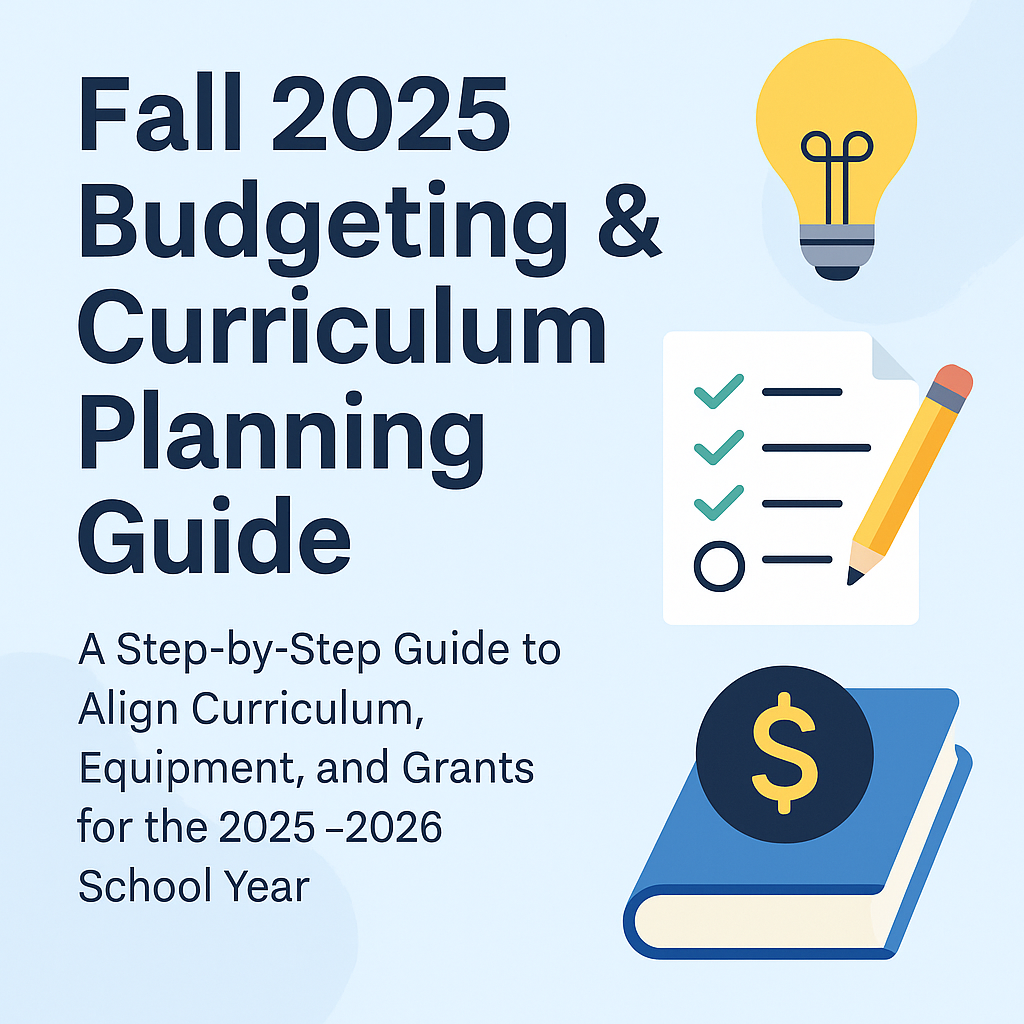8 Step Budgeting & Curriculum Planning Guide
A Step-by-Step Guide to Align Curriculum, Equipment, and Grants

Planning for the upcoming school year can be overwhelming—but it doesn’t have to be. Between balancing budget constraints, evolving industry standards, and the diverse needs of students, CTE educators face increasing pressure to make strategic decisions that drive both short-term results and long-term success. That’s why having a clear, focused planning process is essential.
This guide is designed to help CTE coordinators, instructors, and administrators take a proactive approach to aligning curriculum, technology investments, and professional development with measurable student outcomes. Whether you're updating existing programs, launching new pathways, or responding to local workforce needs, a solid plan ensures every dollar you spend supports career readiness and certification goals.
Whether you’re preparing for upcoming grant submissions or simply reviewing your current program capabilities, this guide will walk you through a thoughtful, step-by-step process to help you assess needs, identify gaps, and build a prioritized roadmap for the year ahead. With the right planning tools in hand, you’ll be able to maximize your budget, engage stakeholders, and create high-impact learning environments that set your students up for success in today’s competitive job market.
Start by identifying the high-level outcomes you want to achieve during the 2025–2026 school year. These goals will guide all future decisions.
- Which industry certifications will your program offer? (e.g., SACA, AWS, FANUC, NCCER, etc.)
- Are you launching new pathways like Semiconductor Manufacturing, Mechatronics, or Renewable Energy?
- Are your goals focused on enrollment growth, student placement, certification rates, or modernization?
Inventory your existing training equipment, software, and curriculum. Evaluate how each resource is performing and whether it aligns with your new goals.
- Create a spreadsheet of your current assets, including model numbers and condition.
- Identify what’s outdated or underused.
- Review curriculum for alignment with current standards and certifications.
- Ask instructors: What’s working well? What’s missing or limiting hands-on opportunities?
Look at what’s preventing your students from engaging fully with certifications or industry-relevant experiences.
- Are you missing key training systems or simulators?
- Do you have enough capacity to support growing enrollment?
- Could portable or hybrid solutions improve space and flexibility?
Now that you’ve defined what you need, it’s time to build a budget and match priorities to available funding.
- Categorize your needs: essential vs. enhancement.
- Match purchases with potential grant funding (Perkins, CTE Incentive, etc.).
- Phase large projects across multiple years if needed.
Even the best equipment can fall short if educators aren’t equipped to use it confidently and effectively.
- Identify professional development or certification training needs.
- Ask vendors about on-site demos, virtual PD, or Solutions Center visits.
- Build training timelines that align with installation or course rollout.
Work collaboratively with stakeholders to build consensus and streamline approvals.
- Present plans to district leadership, advisory boards, or grant teams.
- Gather quotes, specifications, lead times, and justification materials early.
- Use a simple one-pager or slideshow to highlight value and outcomes.
After approvals are secured, keep your implementation organized and well-documented.
- Submit POs early to avoid supply chain delays.
- Schedule installations, training, and curriculum rollout dates.
- Track success metrics such as certifications earned, student satisfaction, and usage rates.
Most CTE programs depend on grants to fund equipment upgrades, certification programs, and teacher training. Building your curriculum and budget strategy with funding requirements in mind can dramatically increase your chances of approval.
- Know your deadlines. Perkins, state-specific CTE grants, and workforce development funds all follow unique cycles.
- Use grant language. Emphasize outcomes like industry alignment, job placement, underserved student access, and credential attainment.
- Prepare documentation. Many grants require quotes, implementation timelines, and PD plans as part of the application.
- Bundle solutions. Combining curriculum, hardware, PD, and certifications into a single purchase request strengthens your proposal.
- Ask for help. Our team can help identify the right solutions and prepare documentation that supports your grant submission.
Need Help Bringing Your Plan to Life?
You don’t have to navigate the planning process alone. Whether you’re building a new CTE pathway from scratch or updating an existing lab to meet evolving certification standards, our team is here to support you. We work closely with educators, administrators, and grant coordinators to recommend hands-on training systems, curriculum packages, and professional development that align with your program goals and funding timeline.
From generating detailed quotes and grant-ready documentation to hosting product demos and Solutions Center visits, we’ll help you take the next step with confidence. Let’s work together to create engaging, future-ready learning environments that prepare your students for success in today’s workforce.
📅 Schedule a Curriculum Planning Call 📘 Download Solutions Guide


